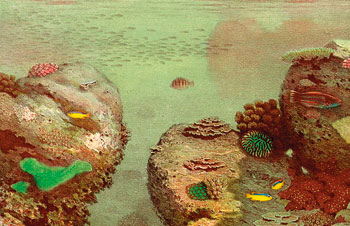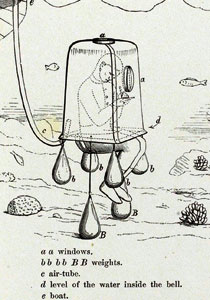| Do you know what the sea bed around our island looks like?
If you’ve had a chance to snorkel near a tropical reef you probably know what amazing things you could find just off the beach.
But in an age before
underwater cameras the only way you could show other people would have been to take them diving…or to introduce them to the work of Eugen Ransonnet-Villez.
An amateur
naturalist, artist and
traveller, Ransonnet-Villez created what may have been the first paintings in the world of underwater coral formations.
The artist would sit in his diving bell, and allow six cannon balls serving as weights to pull him to the seafloor and keep him there while he drew. The bell had a supply of air from a boat, a porthole and a sitting area.
Still, it was likely to be a narrow, uncomfortable space. Nevertheless, he
produced work good
enough to have them
published in his ‘Sketches of the Inhabitants, Animal Life and Vegetation in the Lowlands and High Mountains of Ceylon’ in 1867.
The series has earned Ransonnet-Villez the title of one of the earliest
underwater artists, if not the first. He used the bell in relatively shallow water and his paintings show he faithfully depicted how colours appeared distorted under water. Even today, they have a certain delicate beauty.
Before he arrived in
Sri Lanka, Ransonnet-Villez had previously spent over a decade at the Academy of Fine Arts in Vienna, but he would also study law. Eventually
he would become a
diplomat, but in his spare time Ransonnet-Villez
continued to indulge his love of science, photography and painting, and became especially adept at colour lithography. Before visiting Sri Lanka, he would also go on journey to Palestine, Egypt and India.
Over the course of his travels, Ransonnet-Villez became much sought after as an artist, creating paintings, sketches and lithographs for both his books and pieces by other authors. He has published among others travel from Cairo to the gate to the
Red Sea coral reefs
(Vienna 1863), as well as travel pictures from India, Siam, China and Japan
(Graz 1912).
 |
| Eugen von Ransonnet-Villez,
Submarine rocks, with green corals, c. 1867. |
The work of Ransonnet-Villez is one among many
at 'A Return to Sri Lanka': an exhibition of images of
Sri Lanka from British Collections (1640 – 1900).
This exhibition draws maps, manuscripts,
illustrations, early photographs and paintings of
Sri Lanka from several distinguished British
institutions — principally the British Library, the Victoria and Albert Museum and the Natural History Museum – as well as the National Museum (Colombo).
The exhibition is co-curated by British and
Sri Lankan curators and produced in partnership between the British Library and the British Council (Sri Lanka), with funding provided by the World Collection’s Programme.
Exhibition dates and venues:
- Lionel Wendt Gallery September 14 – 28
- Jaffna Public Library October 5 –19
- Kandy City Centre October 24 – November 6
- Galle Municipal Council November 11 – 24
|



